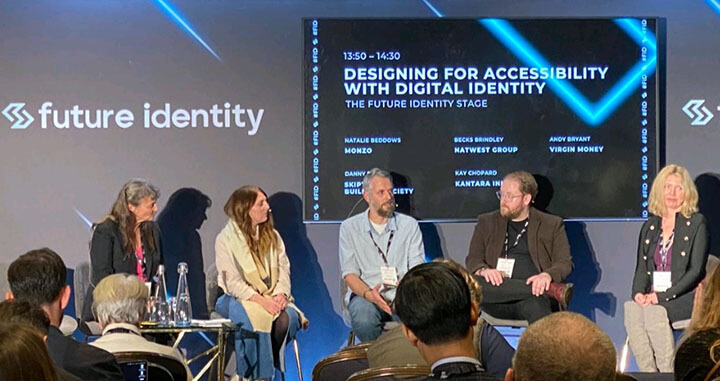
My accessibility journey
Join Lead Designer Andy Bryant as he explains how he became an inclusive designer and shares the five key things he’s learned from 24 years working in digital accessibility.
Late 2023 I was invited to join a panel on digital accessibility in customer identification at the Future Identity Festival. Spending time with young and passionate accessibility experts gave me perspective on my own digital accessibility and inclusive design journey.
Early days
In the late 1990s, long before digital design was broken down into individual disciplines, firms would generally hire one ‘Web person’ to do everything. These were the Good Old Days, long before smart phones or social media, when entire websites were often built in Flash. When we thought Google could never replace Ask Jeeves. Before the Algorithm and SEO even existed.
But they were also the days of woeful accessibility. Like many young designers at the time, it didn’t occur to me that people with vision impairments, or severe motor disabilities, could use the web. We designed beautiful things for people to look at and click on, unaware that a large proportion of the population were becoming excluded – an exclusion that continues to this day.
“What’s accessibility?”
It all changed for me in 2001. I’d recently started as Web Editor at a local authority. Local authorities love their league tables - when they’re at or near the top - but this one was based on 400 local government websites’ accessibility levels and we were in the bottom 10. The Chief Exec came to me and asked “How long to get us in the top 10?”. “What’s accessibility?” I asked in reply.
And that was my first accessibility lesson. In an ideal world, we’re motivated by Doing The Right Thing, but here was potential brand reputation damage that triggered a sudden focus on accessibility. As I would come to learn, don’t question the motive, just grab the opportunity.
So I taught myself about accessibility. I discovered a whole new world of assistive technologies and the features built into Web browsers. I became intimately acquainted with the Web Content Accessibility Guidelines (WCAG), a contentious set of guidelines that would be both a blessing and a curse for the next 20 years. I started to ‘get it’.
But the thing that floored me was when I saw a person with a severe disability using our website for the first time.
Lightbulb moment
We were in Swansea at the Shaw Trust, a brilliant charity who employed a team of people with physical and cognitive disabilities to test websites and offer accreditation. What I saw was a room full of people, all of them struggling to do the most basic task on our site: checking when’s bin day.
The one that’s stayed with me was a young lad with cerebral palsy. He was using a switch device, moving his head to nudge panels either side of him to activate left and right clicks.
An extreme example maybe, but he perfectly encapsulated just how frustrating and alienating the web is when it’s designed and built just for able-bodied, sighted people. We’d asked him to test a benefits application - an 8-page journey with a crazy number of questions. In 4 hours he’d made it close to the end of the first page. I remember his father carrying him out to the car and taking him home, exhausted.
From that moment I considered myself an inclusive designer.
Becoming an inclusive designer
When you meet, talk to and watch the people who struggle most with the web, designing for them becomes part of your thinking.
Because I’d had this epiphany, I thought that was it. Everyone else would follow and on we’d go, making the web accessible. I didn’t realise that 20 years later, despite huge leaps in both technology and design practice, massive chunks of the web would still be closed off to hundreds of thousands of people. And it would still be a battle to get backing, funding and resource.
“Design and build for people, not for a checklist. Don’t let compliance be the sum total of what you aim for.”
But there has always been a community of people who are passionate about making the web an inclusive place. Which brings us back to those talented folk on the panel with me at Future Identity. When it was my turn to talk, what did I have to say in those 40 minutes? it’s all a bit of a blur now, but I knew I wanted to summarise what I’d learned from my 24 years in accessibility. Which is:
1. Accessibility is a practice, not an achievement
This is undoubtedly the most important accessibility lesson I’ve learned. I recently saw a LinkedIn post that described being ‘fully accessible’ as a unicorn, and that’s absolutely right.
I’ve tried designing and building web content to the letter of WCAG and that way madness lies. And anyway, it is entirely possible to build fully compliant content that users will still find frustrating and hard (even impossible) to use. Design and build for people, not for a checklist. Don’t let compliance be the sum total of what you aim for.
2. Take the wins where you can
Most of my successes have come from just doing things I know are right. I’m not suggesting we should all be mavericks – controls and processes are there for a good reason – but an old Virgin motto used to be “screw it let’s do it”. If you know something is going to be the right outcome or approach for users – and you can do it without getting mired in red tape – then do it.
3. Accessibility isn’t hard
Controversial! Let me qualify that.
It’s possible to make any digital content accessible with enough thought, care, attention and technical knowledge. What IS hard is retrofitting: going back and trying to make something inaccessible, accessible. With the right approach – where accessibility is baked into design briefs, content briefs, technical specifications, solution design, acceptance criteria and test scripts – you’ll see how much easier it is to do.
This is a massive culture change, where senior leaders must own and push for accessibility constantly, and it’s where we need to get to at Virgin Money.
4. Inclusive design > accessibility
Designing and building for accessibility has always been about meeting the needs of people with disabilities and working with assistive tech.
More and more now the design community talks about inclusive design: encompassing those aspects of accessibility but increasing the scope to include not only physical disabilities but unseen cognitive disabilities too. Inclusive design also considers context – for example, someone with a broken arm temporarily struggling to use their mobile, or someone for whom English isn’t their first language.
We should all try to talk more about inclusive design, simply because it extends the scope of what we can and should do so much wider.
5. We can’t work around accessibility any longer
I’ve lost count of the times I’ve heard the argument that having inaccessible content is mitigated by the fact that our users have other channels which they can access us and our services – never mind the fact that this might be an appalling user experience. Imagine if the energy we’ve expended on finding ways around poor accessibility had been spent on making the content accessible…
We’re heading into a world where there are no get out clauses. Regardless of any legal threat, Virgin Money has been very vocal about becoming a brilliant digital bank. A brilliant digital bank can’t tell its customers to pop down their branch or give us a ring if they come across something in their banking app that they can’t get to work. It just doesn’t cut it.
But I’m hopeful we’re moving in the right direction. I’m massively encouraged by the fact that I hear my colleagues in the design team not only talking about accessibility, but delivering it – working with other teams, influencing other teams to deliver inclusive experiences. And in the wider business too – amongst developers, analysts, product owners – accessibility and inclusive design has a higher profile than ever.
